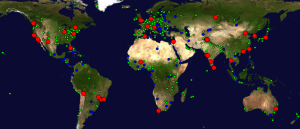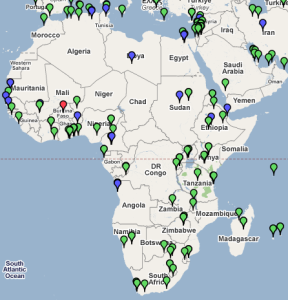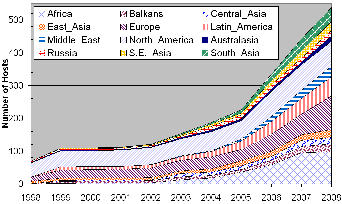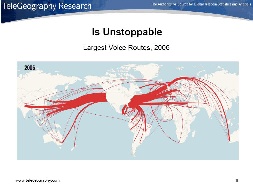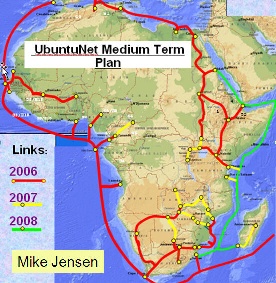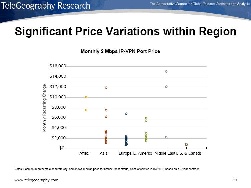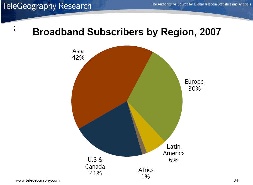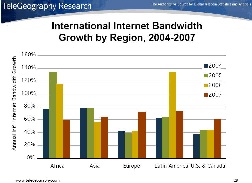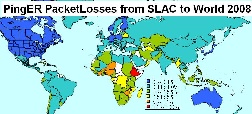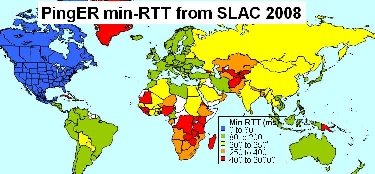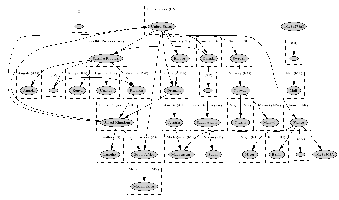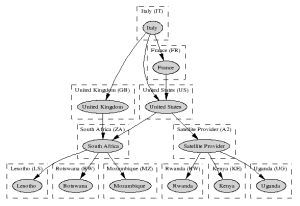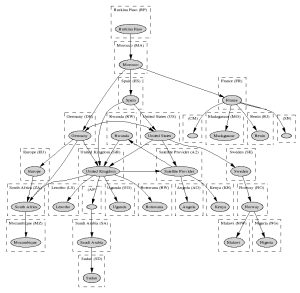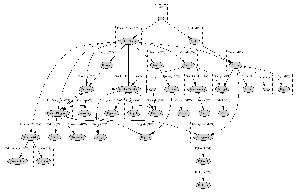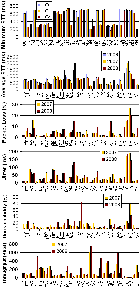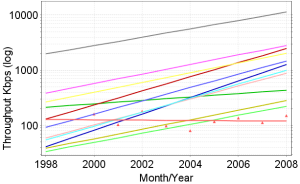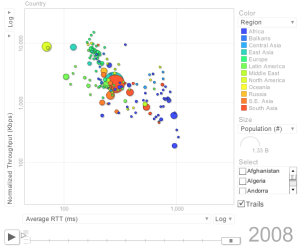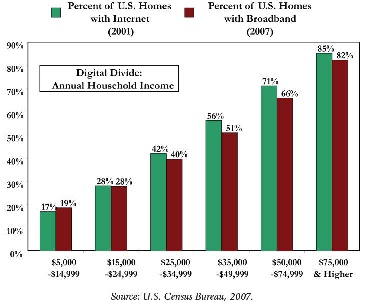PingER
Submarine Fibre Links Connecting Africa
Voice Routes 1997 |
Voice Routes 2007 |
World Cables 2007 |
Africa Cables 2006-2008 Plans |
(c) manypossibilities.net - current |
|---|---|---|---|---|
|
|
|
|
|
Satellite vs Fibre
Satellite is extremely effective in reaching places where the volume of traffic would not justify a fibre connection. Satellite providers are reluctant to talk about prices (except directly with their customers) because it is often difficult to explain to new customers that the lowest prices are only available to large customers with long contracts. However, if pressed satellite operators will say that below US$1800-2000 per mbps per month is not likely to be commercially feasible for them. (See Fibre for Africa).
Satellite networks are often severely bandwidth-constrained and possess high latency. Links may be as narrow as 64K and possess latencies of 250, 500, 750 milliseconds or more. This combination of conditions often leads to congested satellite connections and performance so poor that applications frequently time out. One can attempt to address the delays by improving TCP by increasing buffer sizes to acocmodate the long delays), modifying its congestion algorithm. One can also compress data or use
Regional Comparisons
Inter Regional Traffic |
Price Variation |
Subscribers |
Growth by Region |
Utilization of Available Bandwidth |
|---|---|---|---|---|
|
|
|
|
|
Loss |
Min-RTT |
|---|---|
|
|
Trends
World Regions |
|
|---|---|
|
|
Routing to and within Sub-Saharan Africa
Generated by: PingER Route Visualizer
As seen from SLAC, |
As seen from SEECS/NUST |
As seen from ICTP |
|---|---|---|
|
|
|
As seen from TENET, |
As seen from OUAGA, |
|---|---|
|
|
As seen from UNSW, |
As seen from KHU |
As seen from ACMESECURITY |
|---|---|---|
|
|
|
PingER Performance Metrics
MinRTT, AvgRTT, Packet Loss, |
Derived Throughput (Kbps) |
|---|---|
|
|
Selected PingER Visualizations
Motion Chart |
Motion Chart |
|---|---|
|
|
Recommendations
OECD Information Technology Outlook 2008: Highlights
Top ten ICT policy priorities, 2008
1 Government on line, government as model users
2 Broadband
3 ICT R&D programmes
4 Promoting IT education
5 Technology diffusion to business
6 Technology diffusion to individuals and households
7 Industry-based and on-the-job training
8 General digital content development
9 Public sector information and content
10 ICT innovation support
IHY, eGY, IST Recommendations
- Recognize: can't fix all ills for all people over night.
- Identify focus areas:
- educate teachers & students, attract research (reverse brain drain)
- applications: e.g. education, telemedicine, distance learning ...
- Find energetic leaders from country/region
- Engage policy makers for science, technology, education ...:
- Encourage ICT development, Internet adoption
- Collaborate between institutions, regions to increase leverage
- Form partnerships with vendors & providers:
- Drive market penetration, create demand, long term investments...
- Get support: funding agencies, diaspora, organizations like IHY, eGY, ICTP, professional societies ...
- Make & use measurements to illustrate case for improvement
- Acknowledge need for new business models appropriate for region
EU AU JOINT STATEMENT ON IMPLEMENTATION OF THE EU-AU PARTNERSHIP FOR SCIENCE, INFORMATION SOCIETY AND SPACE.
There are 2 projects under the information society priority
- Africa Connect
- The AfricaConnect project will support the development of regional research and
education networks in Sub-Saharan Africa and their interconnection with the European
GEANT2 network, building on a similar initiative, EumedConnect, implemented in North-
Africa (currently interconnecting around 1,5 Million users across more than 500 research
organisations). The objective will be to contribute integrating the African research
community both at regional and international levels, through interconnection with the most
cost-effective high bandwidth capacity.
- The AfricaConnect project will support the development of regional research and
- The African Internet Exchange System (AXIS)
- This project aims to support the establishment of a continental African internet
infrastructure through national and regional internet exchange points. Such
deployment is considered crucial for the development of the internet in Africa,
generating huge costs savings by keeping local traffic local and offering better quality
of service and new applications opportunities. AXIS activities will include technical
assistance on planning,
- This project aims to support the establishment of a continental African internet
News
Orange to link Madagascar to broadband internet via a new submarine fibre optic cable Paris, March 26, 2008, from Mike Jensen
France Telecom & Orange plan to install a submarine fibre optic cable
providing Madagascar with broadband internet. Known as Lion, the 1,800 km cable will connect Madagascar with the region's existing Sat3-Wasc-Safe cable.
Lion will link Madagascar with the rest of the world via the islands of Reunion and Maurice, the two connection points of the Sat3-Wasc-Safe cable, which itself links Europe to Asia via South Africa. The investment will be made by a consortium including Orange Madagascar, Mauritius Telecom, and France Telecom who will operate the cable jointly. The consortium could later be extended to include other partners.
The investment falls in line with the development policy programmed by the state of Madagascar. It covers the purchasing, the installation of the submarine cable, the construction of a landing station in the region of Toamasina, and a very high speed fibre optic link from Toamasina to the capital.
The submarine cable Lion will contribute to the development of the telecommunications network, a determining factor in the social and economic development of the region. This new very high speed cable provides an excellent international connection for internet-based activity.
For more see http://www.francetelecom.com/en_EN/press/press_releases/cp080326-uk.html.
According to Mike Jensen (priv comm)
Perhaps this is good news for Madagascar, but too early to tell...as it stands now they'll still have to connect upstream to the costly and unreliable SAFE..but there is also rumour that TEAMS will head down to Mauritius, so if that happens then there will be much better upstream bandwidth for madagascar/mauritius/reunion... so yes, SAT3/SAFE is still run on old business model and limited capacity, hopefully it will finally get some real competition!
SEACOM to launch Africa undersea cable June 2009
Reuters, Thursday August 14 2008
JOHANNESBURG, Aug 14 (Reuters) - Mauritius-registered private equity venture SEACOM said on Thursday a fibre optic undersea cable linking east Africa to Europe and Asia would be launched in June 2009, in time for the 2010 soccer World Cup.
The company said in a statement it would start laying the $650 million cable, which is needed to provide high-speed Internet access and spur investment, in October this year.
The 15,000 km cable will wind around the east of the continent between South Africa and Egypt, then on to Mumbai in India and Marseille in France. The group will start connecting sections of the cable in April 2009.
"The team is also trying to expedite the construction in an attempt to assist with the broadcasting requirements of the FIFA Confederations Cup scheduled for June 2009," SEACOM said.
The cable will provide 1.28 terabits per second of broadband capacity to enable high definition TV and provide inexpensive bandwidth.
SEACOM said last year investors in the venture included an arm of the Aga Khan Fund for Economic Development, Venfin Ltd. and Herakles Telecom LLC, each with a 25 percent stake, and Convergence Partners with a 12.5 percent shareholding.
The Shanduka Group, owned by South African black business tycoon Cyril Rhamaphosa, holds the remaining 12.5 percent.
Nedbank Capital, a division of Nedbank and Investec Bank are funding the project.
South Africa's second telephone network operator, Neotel NEO.UL, which is competing with former monopoly Telkom has secured the rights to control the cable's use in South Africa.
South Africa has only one cable linking it to the rest of the world and this was controlled by Telkom until Sept. 2007. (Reporting by Gugulakhe Lourie; editing by Tony Austin)
Google & Satellite coverrage (September 2008)
Google announced this week that it was involved in a radical new plan to bring internet access to the majority of the developing world.
The internet giant has signed up with Liberty Global and HSBC in a bid to launch 16 satellites, which will bring high-speed internet access to Africa and parts of Asia, Latin America, Australia and the Middle East.
The project aims to use low earth orbit satellites instead of fibre cables for the core network, which will link to cellphone towers throughout the developing countries.
This is great news for the telecoms and broadband industry in South Africa, where new players are looking to get into the market to provide some much-needed competition.
The project, which has been dubbed the 03b Network, named after the "other three billion" people for whom fast fibre internet access networks are not commercially viable, is set to come online by the end of 2010.
The 16 satellites will be able to cover all points between 45° north of the equator and 45° south of the equator.
A recent World Bank report titled Broadband for Africa: Policy for promoting the development of backbone networks says the average retail price for basic broadband in sub-Saharan Africa in 2006 was US$366 a month, while in India it was US$44, in Europe US$40 and in the United States US$12.
The report says the major reason for this is the lack of high-quality backbone infrastructure that would allow for affordable mass-market broadband access.
EU-AU Partnership (October 6, 2008)
The African Union Commission and the European Commission have issued a joint statement on the implementation of the EU-AU partnership for science, information society and space.
Among the 19 flagship projects that have been identified, 2 in the field of ICT are ready for early implementation (Africa Connect and the African Internet Exchange System).
The statement can be downloaded at http://www.euroafrica-ict.org/downloads/EU-AU_Joint_Statement_Final_EN_EU.pdf.
Fibre project finished in Botswana
30/10/2008 The multi-million Pula Trans-Kalahari fibre-optic project was recently completed in Botswana. Covering approximately 2000km, the project is expected to act as a catalyst to the growing ICT industry in the country.
Africa's first communications satellite fails (Science and Development Network (November 17, 2008)
By Adole Hassan
ABUJA Africa's first communications satellite has suffered an energy failure just 18 months after its launch.
The NIGCOMSAT-1 satellite was launched from China in 2007 (see Satellite launches boost African communications) amidst optimism that it would aid development by linking up rural communities and progressing telemedicine and long-distance learning. There were also ambitious commercial goals. But these are now dashed, say commentators. The 40 billion Nigerian Naira (US$240 million) satellite was entirely government-owned but was "fully insured," said Rufai.
A geostationary satellite, it was supposed to work for 15 years, and is officially monitored by a ground control station in Abuja, Nigeria, with backup stations in China, Italy, northern Nigeria and the Council for Scientific and Industrial Research (CSIR) satellite applications centre in Hartebeesthoek, South Africa.
Zaku told SciDev.Net that Internet service providers in Nigeria and telecommunications companies who were using the satellite would be moved to other satellites if engineers confirm that it is unfixable.
Other Digital Divides
Economic Digital Divide
As seen below in the graph (from Down Payment on Our Digital Future ) of percent of US homes with the Internet in 2001 and Broadband in 2007 there is a economic digital divide.
A Typology of Information and Communication Technology Users
This sorts Americans into 10 distinct roups of uses of communication and information technology. It shows that:
Some 15% of Americans have neither a cell phone nor internet access. They tend to be in their mid-60s, nearly three-fifths are women, and they have low levels of income and education. Although a few have computers or digital cameras, these items seem to be about moving digital information within the household - for example, using the computer to display digital photos that they take or others physically bring into the house.
Presentations etc.
- "The Strategic importance and impact of e-infrastrucures for Science, Society and Economy in Europe and neighbouring Southern Countries", Robert Klapisch, EUMED 2008, Amman, Jordan 2008
- Digital Divide in Sub-Saharan African Universities: recommendations and monitoring, by B. Barry, M. Petitdidier, L. Cottrell, C. Barton for the IST-Africa conference and exhibition, May 07-09, 2008 Windhoek, Namibia.
- Telegography Telecoms International Workshop, Tim Stronge, Eric Schoonover at PTC'08 13-16 January 2008
- GLOBAL BANDWIDTH RESEARCH SERVICE EXECUTIVE SUMMARY, Telegeography
